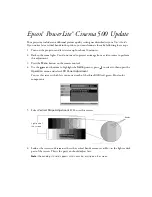
30
9. Troubleshooting & FAQs
Image appears blurred, indistinct or too dark
Adjust the contrast and brightness on
On-Screen Display.
An "after-image", "burn-in" or "ghost image"
remains after the power has been turned off.
Uninterrupted display of still or static
images over an extended period may cause
"burn in", also known as "after-imaging "
or "ghost imaging", on your screen. "Burn-
in", "after-imaging", or "ghost imaging" is a
well-known phenomenon in monitor panel
technology. In most cases, the "burned in"
or "after-imaging" or "ghost imaging" will
disappear gradually over a period of time
after the power has been switched off.
Always activate a moving screen saver
program when you leave your monitor
unattended.
Always activate a periodic screen refresh
application if your monitor will display
unchanging static content.
Failure to activate a screen saver, or a
periodic screen refresh application may
result in severe “burn-in” or “after-image”
or “ghost image” symptoms that will not
disappear and cannot be repaired. The
damage mentioned above is not covered
under your warranty.
Image appears distorted. Text is fuzzy or
blurred.
Set the PC’s display resolution to the same
mode as monitor’s recommended screen
native resolution.
Green, red, blue, dark, and white dots appears
on the screen
The remaining dots are normal
characteristic of the liquid crystal used in
today’s technology, Please refer the pixel
policy for more detail.
The "power on" light is too strong and is
disturbing
You can adjust “power on” light using the
power LED Setup in OSD main Controls.
Audio problem
No sound
Check if audio cable is connected to PC
and monitor correctly.
Ensure audio is not muted. Press OSD
“Menu”, select “Audio” then “Mute”. Check
it on “Off ” position.
Press “Volume” in OSD main control to
adjust the volume.
9.2 General FAQs
Q1:
When I install my monitor what should
I do if the screen shows 'Cannot
display this video mode'?
Ans.:
Recommended resolution for this
monitor:
1920 x 1080
@ 60 Hz.
Unplug all cables, then connect your PC to
the monitor that you used previously.
In the Windows Start Menu, select Settings/
Control Panel. In the Control Panel
Window, select the Display icon. Inside the
Display Control Panel, select the 'Settings'
tab. Under the setting tab, in box labelled
'desktop area', move the sidebar to 1920 x
1080 pixels.
Open 'Advanced Properties' and set the
Refresh Rate to 60 Hz, then click OK.
Restart your computer and repeat step 2
and 3 to verify that your PC is set at 1920
x 1080 @ 60 Hz.
Shut down your computer, disconnect your
old monitor and reconnect your Philips
monitor.
Turn on your monitor and then turn on
your PC.
Q2:
What is the recommended refresh
rate for monitor?
Ans.:
Recommended refresh rate in monitors
is 60 Hz, In case of any disturbance on
screen, you can set it up to 75 Hz to
see if that removes the disturbance.




































